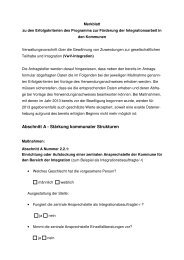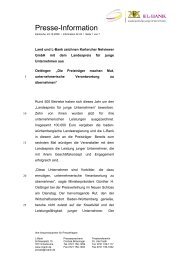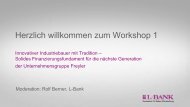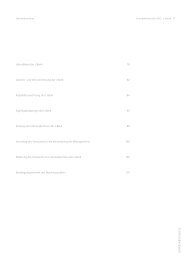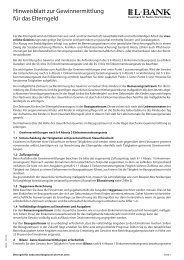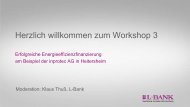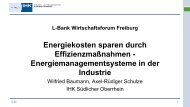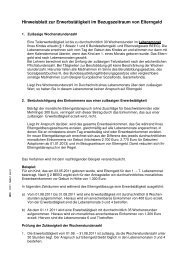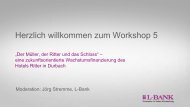Landeskreditbank Baden-Württemberg - L-Bank
Landeskreditbank Baden-Württemberg - L-Bank
Landeskreditbank Baden-Württemberg - L-Bank
You also want an ePaper? Increase the reach of your titles
YUMPU automatically turns print PDFs into web optimized ePapers that Google loves.
carried at the lower of cost or market. That is, while unrealized losses on trading derivatives are recorded in<br />
current income, unrealized gains are not recognized. Hedge accounting is permitted as micro-hedge, portfoliohedge<br />
or macro-hedge (often referred to as a gap hedge). Derivative financial instruments used for hedging<br />
purposes are generally accounted for as off-balance-sheet transactions and, in the case of the bank, are disclosed<br />
in notes to the financial statements. Unrealized gains and losses of both the derivative financial instrument and<br />
hedged items are generally not recorded on the balance sheet or in the income statement. The related income and<br />
expense of a derivative financial instrument, such as interest income related to interest rate swaps, is reported on<br />
a basis consistent with the underlying hedged position pro rata temporis, often resembling synthetic instrument<br />
accounting. Credit-default swaps in the non trading book / investment book provided as credit risk protection are<br />
disclosed as contingent liabilities.<br />
Under U.S. GAAP, all derivative instruments and embedded derivatives are recorded on the balance sheet at<br />
fair value as either assets or liabilities, regardless of any hedge relationship that might exist. Changes in the value<br />
of derivative instruments are recognized in the income statement as they arise, unless they satisfy stringent<br />
criteria for hedge accounting (including designation and high effectiveness), supported by formal documentation.<br />
The accounting treatment of the hedging instruments as well as the hedged items depends on the type of hedge<br />
designation (fair value hedge or cash flow hedge), the offset being in either current income or other<br />
comprehensive income. Also depending on the hedge designation, the carrying value of the hedged item may<br />
need to be adjusted to offset the changes in the fair value of the hedging derivative. Any ineffectiveness resulting<br />
from the hedge relationship is recognized in income.<br />
Loan origination fees<br />
Under German GAAP, the direct costs incurred in the origination of new loans are expensed as general<br />
administrative expense in the period incurred. Loan origination fees received are recognized in the income<br />
statement as commission income upon closing of the transaction unless such fees are determined to be in lieu of<br />
interest. In that case, these fees are deferred and recognized as interest income over the life of the loan (generally<br />
using straight-line amortization).<br />
U.S. GAAP requires that loan origination fees net of certain direct loan origination costs are deferred and<br />
recognized over the life of the related loan as an adjustment of yield using the effective interest method. Loan<br />
commitment fees are deferred, except for certain retrospectively determined fees. Commitment fees meeting<br />
specified criteria are recognized over the loan commitment period; all other commitment fees shall be recognized<br />
as an adjustment of yield over the related loan’s life or, if the commitment expires unexercised, recognized in<br />
income upon expiration of the commitment.<br />
Pension provisions<br />
Under German GAAP, pension obligations are determined using actuarial principles, whereby the ongoing<br />
and future pension obligations and benefit obligations to retired beneficiaries are determined using a certain<br />
valuation benchmark (partial value) in line with tax regulations.<br />
Under U.S. GAAP, the annual pension cost comprises the estimated cost of benefits accruing in the period<br />
as determined in accordance with SFAS 87, “Employers’ Accounting for Pensions” which requires readjustment<br />
of the significant actuarial assumptions annually to reflect current market and economic conditions. Under SFAS<br />
87, a pension asset representing the excess plan assets over benefit obligations is disclosed and deferred in the<br />
balance sheet. The pension benefit obligation is calculated by using a projected unit credit method. Actuarial<br />
gains or losses within a 10% “corridor” are disclosed and can be deferred.<br />
Reacquired own debt securities<br />
Under German GAAP, debt securities that are re-acquired with the intention of resale are recorded as assets<br />
at acquisition cost, and subsequently valued at the lower of cost or market. Gains or losses on resale of such<br />
securities are recorded in current income.<br />
84



